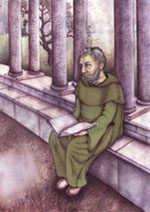 |
 |
 |
 |
 |
 |
 |
|
What did novices read? Stephen of Sawley’s recommendations for those entering the Cistercian life From
all your readings strive to make progress in virtue.
Stephen, abbot of Sawley, who began his monastic career as a monk of Fountains and was then promoted to the abbacies of Sawley, Newminster and finally Fountains, wrote a ‘Mirror of Novices’, a spiritual directory designed to instruct and guide those entering Cistercian life in spiritual and practical tasks. In chapters fifteen and sixteen of the treatise, Stephen deals with reading material and recommends what novices, as beginners, should read first, and what they can then progress to read.(1) Step 1
Step 2 Step 3
Stephen then recommends particularly important books that the novice could read – the Rule of St Benedict, the Confessions of St Augustine and his Commentaries on the Psalter, as well as the twelfth-century sermons of Gilbert of Hoyland on the ‘Song of Songs’. The novice was to read and cherish these works before progressing to other carefully selected writings such as Cassian’s Conferences and Jerome’s Letters, which described the lives of the monks, as well as contemporary works by Aelred of Rievaulx and William of St Thierry. At all times the novice was to choose and read these works ‘with discretion and not a little caution’, that they might instruct him in modesty, perseverance and knowledge of the virtues. |
